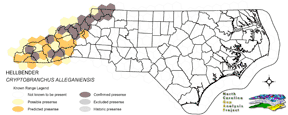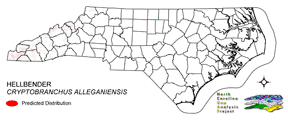
| Taxa: |
| Order: |
| Family: |
| Amphibia |
| Caudata |
| Cryptobranchidae |
| NatureServe Global Rank: |
| NatureServe State (NC) Rank: |
| G4 |
| S3 |
| Federal Status: |
| NC State Status: |
| FSC |
| SC |


| Land Unit |
| US Fish & Wildlife Service |
| US Forest Service |
| US National Park Service |
| US Department of Defense |
| NC State Parks |
| NC University System |
| NC Wildlife Res. Com. |
| NC Forest Service |
| NC Div. of Coastal Mgmt. |
| Local Governments |
| Non-Governmental Org. |
| Other Public Lands |
| Private Lands |
| GAP Status 1-2 |
| All Protected Lands |
| Statewide |
| Hectares |
| 0.00 |
| 3,206.34 |
| 8.10 |
| 1,030.50 |
| 0.27 |
| 0.00 |
| 0.00 |
| 18.30 |
| 0.00 |
| 7.47 |
| 1.62 |
| 0.00 |
| 6,791.40 |
| 1,126.65 |
| 4,262.88 |
| 11,064.00 |
| Acres |
| 0.00 |
| 7,923.04 |
| 20.02 |
| 2,546.42 |
| 0.67 |
| 0.00 |
| 0.00 |
| 56.04 |
| 0.00 |
| 18.46 |
| 4.00 |
| 0.00 |
| 16,781.91 |
| 2,794.84 |
| 10,544.63 |
| 27,350.56 |
| % of Dist. on |
| Prot. Lands |
| 0.0 % |
| 75.2 % |
| 0.0 % |
| 24.2 % |
| < 0.1 % |
| 0.0 % |
| 0.0 % |
| 0.4 % |
| 0.0 % |
| 0.0 % |
| 0.0 % |
| 0.0 % |
| 0.0 % |
| 26.4 % |
| ----- |
| ----- |
| % of Dist. on |
| All Lands |
| 0.0 % |
| 29.0 % |
| < 0.1 % |
| 9.3 % |
| < 0.1 % |
| 0.0 % |
| 0.0 % |
| 0.2 % |
| 0.0 % |
| < 0.1 % |
| < 0.1 % |
| 0.0 % |
| 61.4 % |
| 10.2 % |
| ----- |
| ----- |
|
The hellbender inhabits medium to larger, clear, fast-moving mountain streams in tributary watersheds of the Mississippi River (Wilson 1995). Most major river systems in the western North Carolina mountains have some streams that are occupied. Typically, only streams in predominantly forested watersheds provide the cool, well oxygenated stream conditions required by hellbenders. In the mountains, lengths of stream below 2500 ft. with numerous flat boulder and cobble-sized rocks for shelter are preferred (King 1939, Wilson 1995). Other large submerged objects, such as logs, and bank holes in or at water's edge may also be used for shelter. NATURE SERVE GLOBAL HABITAT COMMENTS: Rocky, clear creeks and rivers, usually where there are large shelter rocks. Usually avoids water warmer than 20 C. Males prepare nests beneath large flat rocks or submerged logs. NATURE SERVE STATE HABITAT COMMENTS: Under rocks in medium to large streams with cool, well oxygenated water. Able to inhabit bank holes where rocks not available. |
|
Peterson, C. L., D. E. Metter, and B. T. Miller. 1988. Demography of the hellbender Cryptobranchus alleganiensis in the Ozarks. Am. Midl. Nat. 119:291-303.
Pfingsten, R. A. 1990. The status and distribution of the hellbender, CRYPTOBRANCHUS ALLEGANIENSIS in Ohio. Herpetol. Rev. 21:48-50. Routman, E. 1993. Mitochondrial DNA variation in CRYPTOBRANCHUS ALLEGANIENSIS, a salamander with extremely low allozyme diversity. Copeia 1993:407-416. Peterson, C. L., and R. F. Wilkinson. 1996. Home range size of the hellbender (CRYPTOBRANCHUS ALLEGANIENSIS) in Missouri. Herpetological Review 27:126-127. Figg, D. E. 1993. Missouri Department of Conservation wildlife diversity report, July 1992-June 1993. 75 pp. Routman, E., R. Wu, and A. R. Templeton. 1994. Parsimony, molecular evolution, and biogeography:the case of the North American giant salamander. Evolution 48:1799-1809. Wilson, L. A. 1995. The Land Manager's Guide to the amphibians and reptiles of the South. Chapel Hill, NC: The Nature Conservancy. Peterson, C. L., C. A. Ingersol, and R. F. Wilkinson. 1989. Winter breeding of CRYPTOBRANCHUS ALLEGANIENSIS BISHOPI in Arkansas. Copeia 1989:1031-1035. Peterson, C. L., J. W. Reed, and R. F. Wilkinson. 1989. Seasonal food habits of CRYPTOBRANCHUS ALLEGANIENSIS (Caudata:Cryptobranchidae). Southwest. Nat. 34:438-441. Peterson, C. L., et al. 1983. Age and growth of the Ozark hellbender (CRYPTOBRANCHUS ALLEGANIENSIS BISHOPI). Copeia 1983:225-231. Barbour, R. W. 1971. Amphibians and reptiles of Kentucky. Univ. Press of Kentucky, Lexington. x + 334 pp. Minton, S. A., Jr. 1972. Amphibians and reptiles of Indiana. Indiana Academy Science Monographs 3. v + 346 pp. Nickerson, M.A. and C.E. Mays. 1973. THE HELLBENDERS:NORTH AMERICAN "GIANT SALMANDERS." MILWAUKEE PUBLIC MUS., PUBL. INBIOL. AND GEOL. NO. 1, 106 P. Mount, R. H. 1975. The Reptiles and Amphibians of Alabama. Auburn University Agricultural Experiment Station, Auburn, Alabama. vii + 347 pp. Johnson, T. R. 1977. The amphibians of Missouri. Univ. Kansas Mus. Nat. Hist., Pub. Ed. Ser. 6. ix + 134 pp. Bury, R. B., C. K. Dodd, Jr., and G. M. Fellers. 1980. Conservation of the Amphibia of the United States:a review. U.S. Fish and Wildlife Service, Washington, D.C., Resource Publication 134. 34 pp. Gates, J. E., R. H. Stouffer, Jr., J. R. Stauffer, Jr., and C. H. Hocutt. 1985. Dispersal patterns of translocated CRYPTOBRANCHUS ALLEGANIENSIS in a Maryland stream. J. Herpetol. 19:436-438. Green, N. B., and T. K. Pauley. 1987. Amphibians and reptiles in West Virginia. University of Pittsburg Press, Pittsburg, Pennsylvania. xi + 241 pp. Collins, J. T. 1991. Viewpoint:a new taxonomic arrangement for some North American amphibians and reptiles. SSAR Herpetol. Review 22:42-43. Dundee, H. A. 1971. Cryptobranchus, and C. alleganiensis. Cat. Am. Amph. Rep. 101.1-101.4. Hillis, R. E., and E. D. Bellis. 1971. Some aspects of the ecology of the hellbender, CRYPTOBRANCHUS ALLEGANIENSIS ALLEGANIENSIS, in a Pennsylvania stream. J. Herpetol. 5:121-126. Mitchell, J. C. 1991. Amphibians and reptiles. Pages 411-76 in K. Terwilliger (coordinator). Virginia's Endangered Species:Proceedings of a Symposium. McDonald and Woodward Publishing Company, Blacksburg, Virginia. |
For more information please contact them at:
NC-GAP Analysis Project
Dept. of Zoology, NCSU
Campus Box 7617
Raleigh, NC 27695-7617
(919) 513-2853
www.basic.ncsu.edu/ncgap